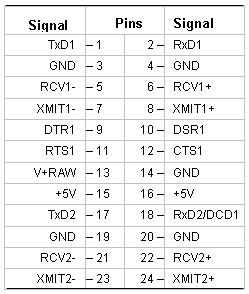


 |
 |
 |
Table of ContentsConnecting To Mosaic Controller RS422/485 Configuration Jumpers Protocol Configuration and Direction Control Registers Overview of the Software Device Driver Functions Installing the UART Module Driver Software Using the Driver Code with Forth UART Direction Control in a Multitasking System C Demonstration Program (in pdf) |
UART Wildcard User GuideUART Wildcard Field HeaderThe serial communications signals are brought out to a 24-pin dual row header on the UART Wildcard as shown in Table 1-4. Table 1-4 UART Wildcard Field Header  TxD1 and RxD1 are the RS232 transmit and receive signals, respectively, for Channel 1. TxD2 and RxD2 are the RS232 transmit and receive signals for Channel 2. RCV1+ and RCV1- are the Channel 1 differential RS422/485 receive signals. XMIT1+ and XMIT1- are the Channel 1 differential RS422/485 transmit signals. To implement an RS485 protocol on Channel 1, install the jumper caps on the jumpers labeled "RS485" in the "Port1" jumper area on the UART Wildcard. This connects RCV1+ to XMIT1+, and connects RCV1- to XMIT1- to implement the half-duplex serial link on Channel 1. RCV2+ and RCV2- are the Channel 2 differential RS422/485 receive signals. XMIT2+ and XMIT2- are the Channel 2 differential RS422/485 transmit signals. To implement an RS485 protocol on Channel 2, install the jumper caps on the jumpers labeled "RS485" in the "Port2" jumper area on the UART Wildcard. This connects RCV2+ to XMIT2+, and connects RCV2- to XMIT2- to implement the half-duplex serial link on Channel 2. DTR1, DSR1, RTS1, and CTS1 are the optional modem handshaking signals. The DCD1 (data carrier detect) modem signal is shared with RxD2 on pin 18 of the header. The hardware automatically routes this signal to the DCD input on the Channel1 UART if Channel1 is configured for the RS232 modem protocol. |
Home|Site Map|Products|Manuals|Resources|Order|About Us
Copyright (c) 2006 Mosaic Industries, Inc.
Your source for single board computers, embedded controllers, and operator interfaces for instruments and automation